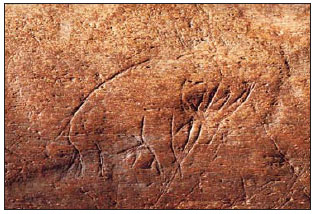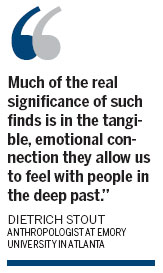Society
Bone piece with carving of ancient beast found
Updated: 2011-06-24 07:53
By Randolph E. Schmid (China Daily)
|
This undated photo from the Smithsonian Institution shows a carved image, at least 13,000 years old, found in Vero Beach, Florida. Smithsonian Institution / Associated Press |
|
|
Image of mastodon or mammoth may be first of its type dug up in Americas
WASHINGTON - A bone fragment at least 13,000 years old, with the carved image of a mammoth or mastodon, has been discovered in the southern US state of Florida, a new study reports.
While prehistoric art depicting animals with trunks has been found in Europe, this may be the first in the Western Hemisphere, researchers report on Wednesday in the Journal of Archaeological Science.
"It's pretty exciting. We haven't found anything like this in North America," said Dennis J. Stanford, curator of North American archaeology at the Smithsonian's National Museum of Natural History and a co-author of the report.
Prehistoric Americans hunted these animals, Stanford explained, and "you see people drawing all kinds of pictures that are of relevance and importance to them".
"Much of the real significance of such finds is in the tangible, emotional connection they allow us to feel with people in the deep past," said Dietrich Stout, an anthropologist at Emory University in Atlanta, who was not part of the research team.
The bone fragment contains an incised image about 7.6 centimeters from head to tail and about 2.5 cm from head to foot.
"There was considerable skepticism expressed about the authenticity of the incising on the bone until it was examined exhaustively by archaeologists, paleontologists, forensic anthropologists, materials science engineers and artists," Barbara Purdy of the University of Florida, the lead author of the study, said in a statement.
The bone was found by a fossil hunter near a place known as the Old Vero Site, where human bones had been found near the bones of extinct Ice Age animals.
It was heavily mineralized, which prevented standard dating, Stanford explained. Still, scientists know mammoths and mastodons had died out in the Americas by 13,000 years ago, meaning it must be older than that. "It could be quite early," he added.
The researchers still wanted to be sure the artifact was not a fake. To that end, they compared it with other materials found at the site and studied it with microscopes, which showed no differences in coloration between the carved grooves and the surrounding material. That, they said, indicated that both surfaces aged together.
"It either had to be carved from direct observation when the animals existed or has to be a modern fake" and "all indications are that the carving is the same age as the bone", said Christopher J. Ellis, an anthropologist with the University of Western Ontario, who was not part of the research team.
The only other report of an ancient bone in North America carved with the image of a mastodon came from Mexico in 1959, but questions were raised about that object and it subsequently disappeared.
Associated Press

Specials

Premier Wen's European Visit
Premier Wen visits Hungary, Britain and Germany June 24-28.

My China story
Foreign readers are invited to share your China stories.

Singing up a revolution
Welshman makes a good living with songs that recall the fervor of China's New Beginning.

